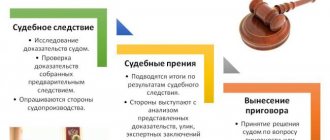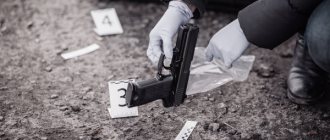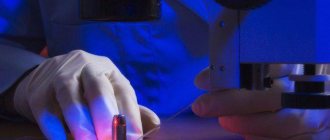Often people contact me with questions about how to return property and things seized by law enforcement officers during a criminal investigation.
The procedure for storing, recording and returning items seized during investigative actions is regulated by Art. Art. 81, 82. Code of Criminal Procedure of the Russian Federation. Physical evidence must be kept in a criminal case by the person conducting the investigation or by the judge until the verdict enters into legal force or until the expiration of the period for appealing the decision or ruling on termination of the criminal case and transferred along with the criminal case, except for the cases provided for in these articles. When transferring a criminal case from one investigative body to another or from one investigator to another, as well as when sending a criminal case to the prosecutor or to the court, or when transferring a criminal case from one court to another, material evidence is transferred along with the criminal case. Disputes about the ownership of material evidence are resolved through civil proceedings. In the event that a dispute over the right to property, which is material evidence, is subject to resolution through civil proceedings, the material evidence is stored until the court decision comes into force.
The concept of physical evidence
Physical evidence is objects collected in the manner prescribed by law that have properties capable of establishing circumstances relevant to the case. Physical evidence is one of the most important types of evidence in a criminal case. Items that can be used as material evidence in a criminal case are examined, recognized as material evidence and added to the case, about which a decision is made.
In accordance with Part 1 of Art. 81 of the Code of Criminal Procedure of the Russian Federation, the following are recognized as material evidence in a criminal case:
- any items that served as a weapon, equipment or other means of committing a crime or retained traces of a crime (for example, bladed or firearms, clothing with traces of blood, a glass with fingerprints, a lock with signs of burglary on an apartment door, lock picks, devices for production of counterfeit banknotes, etc.);
- any items that were the target of criminal actions (for example, a stolen car, a fake diploma, etc.);
- money, valuables and other property obtained as a result of committing a crime;
- objects and documents that can serve as means for detecting a crime and establishing the circumstances of a criminal case.
When passing a sentence, as well as a ruling or resolution to terminate a criminal case, the issue of the fate of the material evidence must be resolved. Wherein:
- the instruments of crime belonging to the accused are subject to confiscation, or transferred to the appropriate institutions or destroyed;
- items prohibited for circulation are subject to transfer to the appropriate institutions or are destroyed;
- light industrial goods withdrawn from illegal circulation are subject to destruction;
- items that are of no value and not claimed by the party are subject to destruction, and in the event of a request from interested persons or institutions, they can be given to them;
- money, valuables and other property obtained as a result of the commission of a crime, and income from this property are returned to the rightful owner;
- money, valuables and other property specified in paragraphs “a” - “c” of Part 1 of Art. 104.1 of the Criminal Code of the Russian Federation are subject to confiscation (for example, used or intended to finance terrorism, extremist activities, an organized group, an illegal armed group, a criminal community);
- documents that are material evidence remain with the criminal case during the entire storage period of the latter or are transferred to interested persons and institutions;
- the remaining items are transferred to the legal owners, and if the latter are not identified, they become the property of the state.
Objects, including electronic storage media, and documents seized during pre-trial proceedings but not recognized as material evidence must be returned to the persons from whom they were seized. Documents may contain information recorded both in writing and in another form. These may include photographic and film materials, audio and video recordings and other media. After investigative actions are taken and in the event that it is impossible to return the electronic media seized from him to the rightful owner, the information contained on these media is copied and transferred to the latter, about which a protocol is drawn up. The persons to whom material evidence can be transferred (returned) are the legal owner or the state. The legal owner is the one in whose possession, use or disposal the above property was lawfully and was disposed of as a result of a crime committed or in connection with a criminal case. For some material evidence (for example, bulky items, large quantities of goods, perishable products, seized from illicit trafficking in narcotic drugs, alcohol and alcohol-containing products, money, valuables, etc.), a special procedure for storage, accounting and the possibility of their early sale or destruction has been established. recycling. Accordingly, material evidence can be returned to their owners even before the completion of the criminal proceedings. This is possible when the owner of the material evidence is obvious, the ownership of the thing is indisputable, it has already played its role in proving, or a thorough examination and photography make further retention of the item at the disposal of the investigative body or court unnecessary. When items are returned to their owners, the investigator, investigator, and also the judge attach a document confirming this fact to the materials of the criminal case, usually a receipt from the owner to whom the seized items were returned. The owner of the returned property is restored to all his previous rights as an owner, tenant, etc. One should distinguish from the return of material evidence their transfer to the owner for safekeeping, when the responsible person has no right to either use or dispose of the stored property belonging to him, since he is obliged to ensure the safety of the property transferred to him for safekeeping. The deadline for returning items to their owners is not defined by law.
Design rules
The possibility of their further use in the course of joining the case, investigation and compilation of the evidence base depends on the extent to which the evidence is correctly prepared from the legal side.
As mentioned above, the procedure, rules for the seizure and inclusion of a specific type of evidence depend on the group of the subject:
- Legal way to discover evidence. For example, the use of information received from a witness who, in accordance with the established procedure, testified publicly in court in a criminal case, with entry into the minutes of the court session.
- Compliance with the procedure for seizure (seizure) of evidence. It must also comply with the rule of law and due process.
- Attaching materials to the case.
- Storage of evidence.
- The further fate of items seized from their owners or from the circulation of the enterprise.
Compliance with this procedure allows you to competently legitimize the subject, preserve all the distinctive characteristics reflected by this crime, and in the courtroom truly speak about the guilt or innocence of the suspect.
Detection and seizure
These events occur during one of the investigative actions.
It could be:
- search;
- inspection;
- investigative experiment;
- notch;
- other investigative actions strictly legalized by the Criminal Procedure Code.
The list of required documents depends on the location and location of the future evidence.
For example, if an item may be found in the apartment or office of a person who is not a participant or defendant in the case, but is the owner of this property, his written consent to inspect the premises is required.
When registering the discovered subject of a crime, the presence of at least two people participating as witnesses is required.
In addition to witnesses, investigators and participants in the case, when identifying objects that require special skills and abilities to handle them, specialists may be involved in the seizure procedure. With their help, the characteristics of the subject under study are recorded, as well as the identification of factors necessary for the investigation that determine the nature of the crime and some details. The participation of any additional persons is reflected in the protocol of seizure (seizure), and is also reflected in the protocol of the court session.
In cases of discovery and seizure of several material evidence at once, in addition to the protocol, an inventory is drawn up, which contains the full names and distinctive features of the seized items. In this case, a note is made in the protocol about the preparation of the inventory.
If necessary, it is examined at the place where evidence was found. This action allows, taking into account the location of the item, to specifically describe and characterize the evidence found. All identified information is recorded in the inspection (seizure) protocol, and the item being described is photographed or filmed.
Getting involved
This procedure is carried out after the seizure of an item related to a criminal case. Physical evidence is added to the materials of the criminal case by issuing a ruling by the court or the investigator in the case. Moreover, this resolution provides references to documents drawn up during the seizure.
The latter must fully reflect the extraction process, as well as the characteristics and distinctive features of the item:
- Date and place of seizure.
- Full name of all participants in the investigative action (indicating positions and positions).
- Conditions for the discovery of evidence and the immediate action to seize it.
- Descriptive characteristics of an object (its weight, color, shape, etc.).
- Actions of the investigator regarding packaging and typing of the evidence package.
- The procedure for transfer, as well as determining the place of storage of the item (in accordance with Article 82 of the Code of Criminal Procedure of the Russian Federation).
Without a court ruling on the inclusion of evidence in the case, this item is not evidence in a criminal proceeding and must be returned to its rightful owner. Documentary registration of a fact allows you to protect the investigation from illegal substitution of evidence, as well as its disappearance (theft).
Responsibility for the safety of material evidence
Responsibility for the safety of material evidence attached to a criminal case lies with the person conducting the investigation, and in court, with the judge or chairman of the court. Only these persons are authorized to decide on the return of material evidence to its owner. In the event of loss or damage to property, an item recognized as material evidence and subject to return to the rightful owner, the authority that did not ensure its safety bears civil property liability to the owner.
To return seized items, it is necessary to write a petition for the return of material evidence from the criminal case materials addressed to the investigator or judge. This petition must be considered within three days. In case of refusal to return material evidence, the person who filed the petition has the right to appeal the decision in the manner prescribed by law.
Meaning
Evidence plays an important role in the investigation of a crime. The presence or absence of objects of a crime can significantly affect the course of events in the case under consideration. Therefore, the procedure for searching, identifying, and also introducing evidentiary material into criminal cases is fixed by paragraphs of the Criminal Procedure Code of our country.
Participants in court hearings, be they judges, prosecutors or lawyers, agree that the subjects of a crime much better reflect the nature, circumstances and motives of an unlawful criminal act committed by a particular person than inquiries, interrogations and other methods of investigation.
Physical evidence is an inanimate object, a thing that cannot lie. It carries the primary signs of a crime and can characterize the suspect or victim to varying degrees.
This is achieved by grouping evidence into categories:
- Exculpatory.
- Accusatory.
- Additional.
The latter indicate, confirm (refute) or supplement the main material evidence of the criminal case.
If there are several pieces of evidence in a case, they should complement each other, reveal the overall picture of the crime, but not exclude them in any way.
When adding a new object or subject to a case, the determining factor is the order of receipt, inclusion, as well as documentation of the object as evidence. The list of these procedures depends on the classification of items of evidence, their features, forms and affiliation.
Sample petition for the return of material evidence from the criminal case materials to the court
Judge of the Dzerzhinsky District Court of Perm A.A. Petrova convicted Ivanov Ivan Ivanovich, born **.**.1990, native of Perm, registered and residing at the address: Perm, st. Turgeneva, d. **, apt. **
Petition
ABOUT THE RETURN OF EVIDENCE
FROM THE CRIMINAL CASE MATERIALS
By the verdict of the Dzerzhinsky District Court of Perm dated March 20, 2018. in criminal case No. **** I, I.I. Ivanov, was convicted under Part 1 of Art. 228 of the Criminal Code of the Russian Federation, a sentence of imprisonment for a period of 1 (one) year was imposed, on the basis of Art. 73 of the Criminal Code of the Russian Federation conditionally, with a probationary period of 1 (one) year. By resolution of the investigator of ORPOT of the Dzerzhinsky district of the Investigative Directorate of the Ministry of Internal Affairs of Russia for the city of Perm No. **** dated 10.16.2017. were recognized as material evidence and added to the materials of criminal case No. **** against me, I.I. Ivanov, accused of committing a crime under paragraph “b” of Part 3 of Art. 228.1 of the Criminal Code of the Russian Federation, the following items: 1. funds in the amount of 40,000.00 (Forty thousand) rubles; 2. mobile phone “Samsung GT-S5230” IMEI **** S/N**** in a black case with a “Tele2” SIM card worth 10,000.00 rubles; 3. laptop “Samsung Galaxy S9+ (SM-G965)” model No. **** in a black case worth 50,000.00 rubles; 4. a cross with a yellow metal chain worth 30,000.00 rubles. Guided by Art. Art. 81; 82 of the Code of Criminal Procedure of the Russian Federation, in connection with the passing of a sentence in a criminal case,
I ASK:
return the specified items: 1. funds in the amount of 40,000.00 (Forty thousand) rubles; 2. mobile phone “Samsung GT-S5230” IMEI **** S/N**** in a black case with a “Tele2” SIM card worth 10,000.00 rubles; 3. laptop “Samsung Galaxy S9+ (SM-G965)” model No. **** in a black case worth 50,000.00 rubles; 4. a cross with a chain made of yellow metal worth 30,000.00 rubles, attached to the materials of the criminal case, to me, their rightful owner. Signature: (I.I. Ivanov) Date: 03/20/2018
If you need a criminal lawyer in Perm, then you have definitely come to the right place. Criminal cases are my key area of expertise.
Storage order
The standards for the procedure for storing evidence in a case are determined by the provisions of Article 82 of the Criminal Procedure Code of Russia and the “Instructions on the procedure for the seizure, recording, storage and transfer of material evidence in criminal cases, valuables and other property by preliminary investigation bodies, inquiries and courts (approved . Prosecutor General's Office of the USSR, Ministry of Internal Affairs of the USSR, Ministry of Justice of the USSR, Supreme Court of the USSR, KGB of the USSR October 18, 1989 No. 34/15)", which reads:
- “When storing and transferring material evidence, awards, valuables, documents and other property, measures are taken to ensure the preservation of the seized objects’ signs and properties, due to which they have the value of evidence in criminal cases, as well as the traces on them, as well as the safety of the objects themselves.” evidence, valuables, documents and other property (if they cannot be transferred for storage to victims, their relatives or other persons, as well as organizations);
- evidence is stored in a criminal case, and if it is cumbersome or for other reasons, it is transferred for storage, about which a protocol is drawn up;
- To store evidence in internal affairs bodies, KGB bodies, prosecutor's offices, and courts, special rooms with shelving, a metal-lined door, barred windows, and security and fire alarms are equipped. In the absence of such a room, a special storage facility is allocated (safe, metal cabinet of sufficient size, etc.);
- Responsible for the safety of evidence attached to the case is the person conducting the investigation or inquiry, and in court - the people’s judge or the chairman of the court.”
Items such as bullets, spent cartridges, and glass fragments may be located directly in the criminal file (in a separate file or package). Murder weapons and firearms are stored in a specially equipped place, the requirements for which are described above.
Also, depending on the own characteristics of each object, their quantity, storage temperature requirements, their placement conditions are determined individually. For example, perishable products that were purchased illegally must be left in a refrigerated room or, if necessary, transported to another place that provides the specified storage temperature, or sold through grocery stores.
During the sale, a video recording of the entire seized batch of goods is first made, which is noted in the seizure protocol.
In addition to sale, if necessary, the seized goods may be destroyed in the prescribed manner, indicating this action in the protocol of seizure and the protocol of the criminal investigation.







